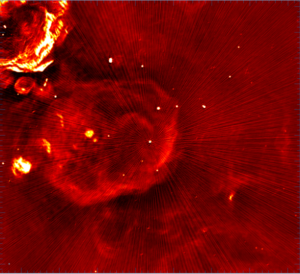Project area/S
- Pulsars and Fast Transients
Project Details

The MeerKAT image of the intriguing 44-minute period object we recently discovered.
We recently made an intriguing discovery with the Australian Square Kilometre Array Pathfinder, located in Western Australia. We detected a mysterious, extremely bright source that has a long period. This source turns on every 44 minutes and exhibits unusual behavior for 3 minutes. To understand this phenomenon better, we conducted follow-up observations using state-of-the-art telescopes worldwide.
As part of this research, a student will work with data from the ASKAP radio telescope in Western Australia and the MeerKAT radio telescope in South Africa. They will learn how to create radio images using the data from radio interferometers. Additionally, the student will generate light curves and dynamic spectra of the source to investigate the evolution of its pulse properties, including millisecond sub-pulse structures.
Student Attributes
Academic Background
Physics/Astronomy preferred but not necessary
Computing Skills
Some experience in coding, e.g. in Python (preferred but not necessary)
Training Requirement
Some basic Linux and supercomputing usage may be useful
Project Timeline
| Week 1 | Inductions and project introduction |
| Week 2 | Initial presentation |
| Week 3 | Learning basics of radio interferometers and ultra-long period transients, installing software for radio interferometers data reduction |
| Week 4 | Learning how to make images from calibrated visibility data, and making radio images from the ASKAP-CRACO visibilities |
| Week 5 | Learning how to do proper calibration on radio interferometer data, and making radio images from MeerKAT visibilities |
| Week 6 | Making lightcurves and dynamic spectra based on the images created in Week 4 and 5, and measuring the basic source properties (e.g., DM, spectral index, period) |
| Week 7 | Writing scripts to automate the process of making images, lightcurves, and dynamic spectra |
| Week 8 | Investigating evolution of the pulse properties in from milliseconds- to hour-long timescale |
| Week 9 | Final presentation |
| Week 10 | Final report |

